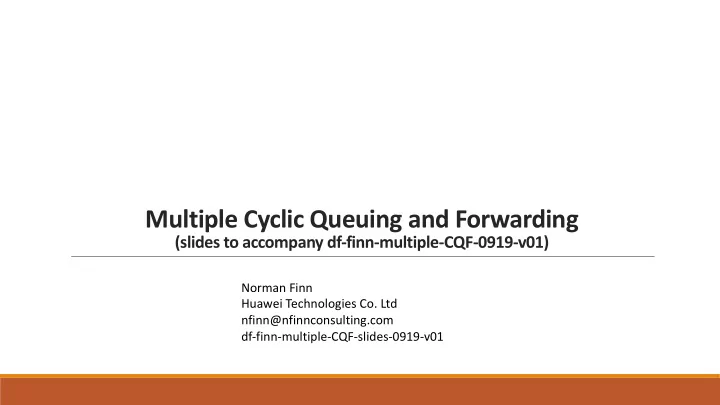

Multiple Cyclic Queuing and Forwarding (slides to accompany df-finn-multiple-CQF-0919-v01) Norman Finn Huawei Technologies Co. Ltd nfinn@nfinnconsulting.com df-finn-multiple-CQF-slides-0919-v01
Why this paper? Cyclic Queuing and Forwarding is perceived as having major flaws, which prevent its adoption: It is difficult to pick a cycle time: • A long cycle time produces long end-to-end latency. • A short cycle time severely restricts the number of flows handled. • No one cycle time serves more than a narrow range of requirements. • Having 2-buffers per hop precludes long links. • With a little imagination, these issues can be solved without adding anything to IEEE 802.1Q, so the solutions are suitable for P802.1DF.
Step 1: You can run with 3 buffers, not 2 ! With 2 buffers, you change input buffers at the same moment that you change output buffers. Link delay and forwarding delay have to be subtracted from the useful ! bandwidth, to prevent filling and emptying a buffer at the same time. ! If you have 3 buffers, then you can change to the next input buffer at a different phase of the cycle from when you change to the next output buffer. Each buffer spends part of a cycle idle; one cycle per hop is added to the ! latency. But, the link delay and forwarding delay are no subtracted from the ! bandwidth..
Two buffers Two buffers per port. Input and output buffers swap at the same moment, once every cycle, period T C . Small guard band to allow for link delay and forwarding delayu. All bridges are synchronized and swap buffers at the same moment. Cycle time T C > transit time + forwarding time + clock inaccuracy + max data transmit time. 4 7/16/2018
Two buffers TICK! 5 7/16/2018
Two buffers TICK! 6 7/16/2018
Three buffers Input buffer swap is out-of-phase with output buffer swap to allow for arbitrary link delay. No guard band needed for link/forwarding delay. Each buffer cycles through four states: filling, full, draining, empty 7/16/2018 7 7 7/16/2018
Three buffers TICK! 7/16/2018 8 8 7/16/2018
Three buffers TICK! 7/16/2018 9 9 7/16/2018
Three buffers TICK! 7/16/2018 10 10 7/16/2018
Three buffers TICK! 7/16/2018 11 11 7/16/2018
Three buffers TICK! 7/16/2018 12 12 7/16/2018
Three buffers TICK! 7/16/2018 13 13 7/16/2018
N buffers Any number of buffers per port. Useful for delay matching on different paths. 7/16/2018 14 14 7/16/2018
The number of buffers used by a stream ! Different output ports on one system can have different numbers of buffers. ! Different input ports feeding the same output port can each use a different number of the buffers on that output port. ! One Stream can use a different number of buffers at each output port along the path.
df-finn-multiple-CQF-0919-v01 Figure 1 Reference timelines for time-based CQF T=0 T=1 T=2 T=3 NODE A Timeline 1: Transmitting frames from Node A allocable to Streams T A + T P dead buffer time T B max interference time T I variation time T V minimum link delay = 1.3 T C NODE B T=0.3 T=2.3 T=3.3 Timeline 2: T=1.3 2-buffer: discard Assigning frames to output buffer in Node B 3-buffer: send to buffer a Slope of maximum 2-buffer: send to buffer c forwarding delay Minimum forwarding delay 3-buffer: send to buffer a Maximum forwarding delay Forwarding delay variation NODE B T=0.5 T=2.5 T=1.5 T=3.5 Timeline 3: T W wait Storing frames in output buffers in Node B time T=1 T=2 NODE B T=3 T=0 Timeline 4: Transmitting frames from Node B output continues (2-buffer) output continues (3-buffer)
Example of Multiple cycle times on one output port ! Four cycle times at four priorities 3-6. ! 1 priority 3 cycle, buffers h, i (not shown) ! 3 priority 4 cycles, buffers f, g ! 6 priority 5 cycles, buffers d, e ! 24 priority 6 cycles, buffers a, b, and c.
Transmission order ! The total bandwidth allocated over all CQF priorities cannot exceed the link bandwidth. ! Draining of CQF buffers are by strict priority, fastest cycles first ! As long as every cycle is an integer multiple of the next-faster cycle, every buffer will empty before the end of its cycle. Best effort 4 5 6 Time -->
More ways to improve the options available to CQF. ! Preemption: ! Lowers the interference from lower-priority queues, especially best-effort ! CQF queues can be preemptable , because the preemption penalty is bounded. ! Packing varied frame sizes into cycles can require overprovision: ! “Sausage making,” packing the customers’ packets into fixed-sized encapsulations, requires much less overprovision, and can be done at the edges of a Service Provider network. ! In multiple CQF, deliberate overprovision of a Stream (assigning it to a too-fast cycle) reduces its latency.
The multiple-CQF value proposition ! CQF, as described here, requires network time synchronization. ! CQF requires time-aware state machines on input/output ports. but, ! Except, perhaps, for the ingress bridge, CQF requires no per- Stream configuration, no per-Stream state machines, no per- Stream knowledge at any node in the network. ! CQF allows a network controller to perform admission control with no per-flow conversations with any (except perhaps the ingress) nodes in the network.
To come … There are many more improvements that can be made to TSN, many of which require no new standards. I hope to supply more papers and presentations in this vein.
Thank you
Recommend
More recommend